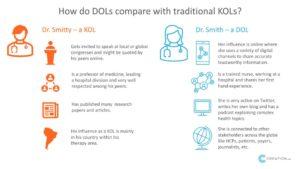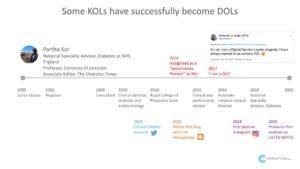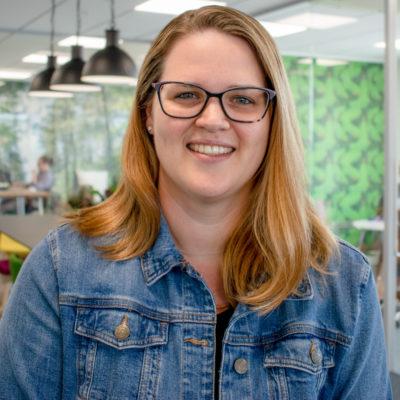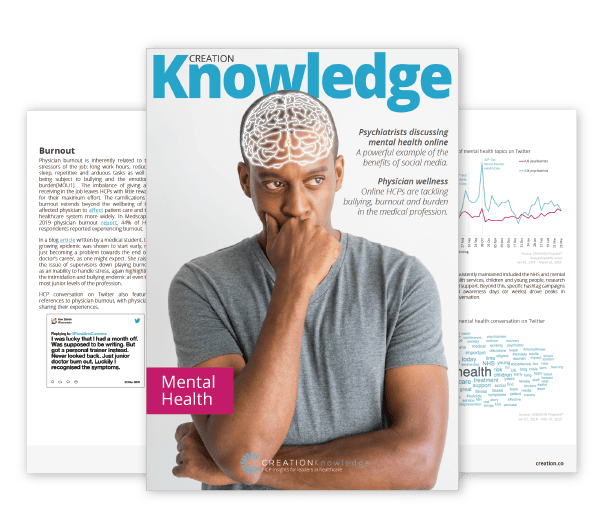How to avoid disappointment in identifying Digital Opinion Leaders
We very recently attended the Reuters Event Pharma 2022 in Nice. There were lots of good discussions and sessions around customer-centric, cross-functional, AI technology and omnichannel buzzwords.
Some pharmaceutical companies are making bold moves and trying out new things. Like not having sales teams anymore or medical affairs influencing the full spectrum of a company’s efforts or introducing new engagement models to deliver best-in-class customer experience or using social media to better understand customer behaviours for increased personalisation.
I was genuinely surprised not to hear more about Digital Opinion Leaders (DOLs). Yes, it came up every now and then but usually in the context of Key Opinion Leaders (KOLs).
Traditional KOLs, active online KOLs and DOLs
Especially in the last two years, we have observed that many of our clients are somewhat unsure about the difference between KOLs and DOLs. There are many great agencies and solutions out there that do incredible work when it comes to KOL mapping and profiling. They usually provide a large database with hundreds of names and you can identify very quickly the right KOL for you based on therapy area, location, abstracts and research work and their collaboration and engagement with other KOLs. Most of those solutions now also include social media data which is great as you can understand if your KOL is active online and the platforms they are using and what is being discussed. Let’s call these active online KOLs.
But what is the difference between a DOL, a traditional KOL and an active online KOL?
By definition, there are significant differences when it comes to traditional KOLs, active online KOLs and DOLs:
- A traditional KOL is typically a respected medical expert highly regarded in their field as a result of their innovative research at respected institutions, publications in high-impact research journals, and presentations at renowned conferences.
- Active online KOLs are traditional KOLs who are also active online and are part of the wider health online conversation.
- We would define a DOL as any individual or organisation, who influences the view or behaviour of other health stakeholders through their digital activity.

Some KOLs have successfully become DOLs like Partha Kar for example here in the UK.

So, while there can be an overlap between active online KOLs and DOLs, we tell our clients to expect between 10-20% of identified DOLs to also be online active KOLs. But this is not always the case and sometimes there is no overlap at all. How exciting it is when we hear our clients say “But I don’t know any of those names!”.
Why is identifying DOLs important?
DOLs are identified based on different metrics and methodologies but the most important question to answer is “Why do you need DOLs?”. If you are looking for a DOL who is influencing health policy then this is different to a DOL influencing disease awareness. We can not stress enough how important it is to fully understand why you need DOLs, what are you trying to solve and what success would look like. The answer to those questions form part of our methodology to identify the right DOLs for you which we outline in a recent webinar. You might also want to measure success and identify ROI for DOL engagement then those questions become even more important. Don’t rush this process and take your time! The precise definition of a Digital Opinion Leader depends on what you see as important, this will affect which DOLs are relevant to you.
What makes an HCP a DOL?
Which HCPs are considered Digital Opinion Leaders depends on numerous factors. Over recent years, as we have developed and refined our methodologies for studying HCP Digital Opinion Leaders, we have been able to pinpoint factors that determine an individual HCP’s significance with increasing accuracy. This allows our clients to examine the evidence for an HCP as a Digital Opinion Leader and develop an informed view on who the most significant individuals are, in the context of their specific needs and interests.
There are many factors to consider but here are 7 simple metrics involved in identifying HCP DOLs:
- Do they post relevant content?
- Do they have an HCP or public following?
- Are they trusted among online peers?
- Are they active in the online conversation?
- Do they have public influence?
- Do they have a social media presence?
- Are they in existing relationships with you?
So, how to avoid disappointment when identifying your DOLs?
We started by asking the question of whether KOLs, active online KOLs, and DOLs are the same. The answer is usually no! They are very different and are identified based on different metrics which we have explored above.
To recap:
- Similarities are:
- Their opinion leadership: expert knowledge and influence
- Social media presence: active online KOLs and DOLs both have a social media presence and might be using multiple channels
- Key differentiators are:
- The source of their influence
- Seniority of role
- The content they share
- Geographical influence level
Your list of KOLs, even if some of them are active online, can not be translated 100% into a list of DOLs. To avoid disappointment, time and money make sure that you and your internal team have answered the key questions of “why do we need DOLs?”, “what are we trying to solve?” and “what would success look like?”.
To support you in answering these questions and understanding what is possible, we have a series of webinars for pharmaceutical companies available on the topic of DOL identification and engagement:
- New Webinar: Identifying your Rising Star DOLs
- Webinar: The beginner’s guide to DOLs
- Webinar: Understanding the differences between DOLs and KOLs
- White Paper: Digital Opinion Leaders are more important than ever
Please speak to us if you have any questions or would like to find out more, we’d love to chat.
 By Anni Neumann
By Anni Neumann 


